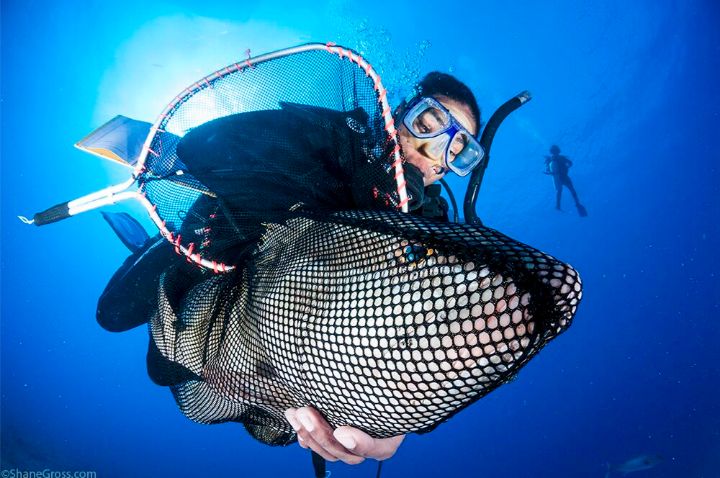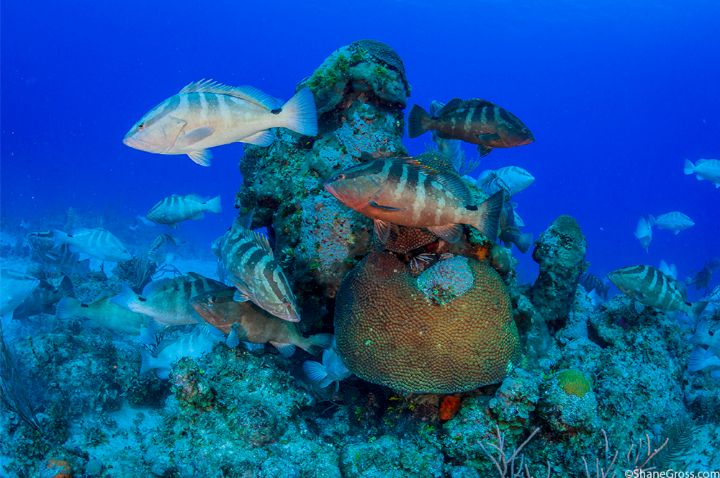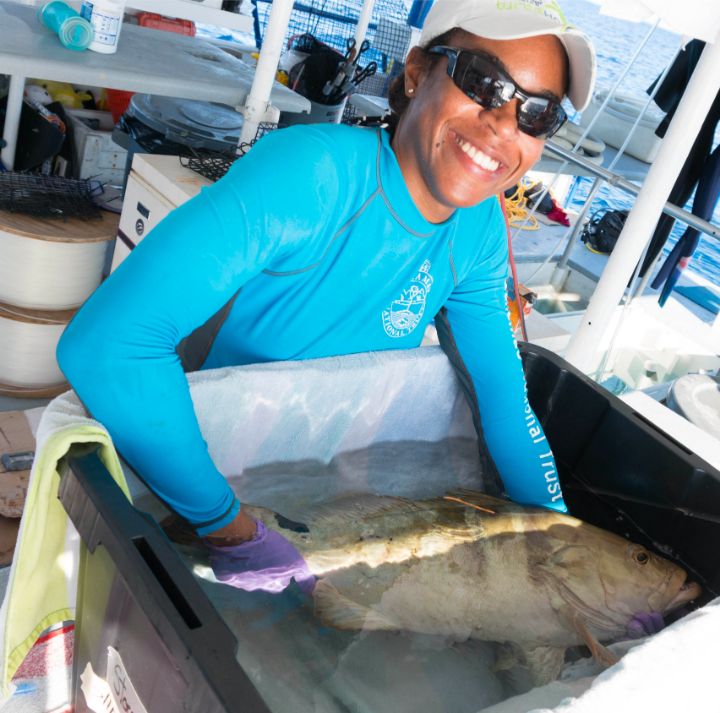|

|
 |
|
Last Updated: Mar 26, 2020 - 7:52:24 PM |

Bahamian marine scientist, Dr. Krista Sherman releasing a tagged Nassau grouper in Long Island as a part of her research into the nation’s grouper population. Photo: Shane Gross for the Perry Institute of Marine Science
|
Genetically different Exuma, Long Island fish need better protection
A newly released research study is shedding more light on the Nassau grouper in hopes of helping the nation meet its conservation goals for a critically endangered species that is as important to the economy as it is to ecology.
The research, led by a Bahamian marine scientist, was published in the latest edition of Frontiers in Marine Science.
“Grouper is really important for us in The Bahamas through the value it provides for fisheries, food security and in maintaining healthy marine ecosystems. For that reason, we need to try and understand as much as we can about how grouper our populations are doing,” said Dr. Krista Sherman, senior scientist at the Perry Institute of Marine Science (PIMS).
Slow growth rates and predictable breeding places and times make the Nassau grouper extremely vulnerable to over-fishing. It is commercially extinct in many areas and listed on the IUCN (International Union for the Conservation of Nature) Red List of threatened species.

Nassau grouper in Exuma and Long Island are genetically distinct from the same species elsewhere in The Bahamas, according to a new research study. Photo: Shane Gross for the Perry Institute of Marine Science
|
“We need to understand how populations are connected, how they’ve changed, how our activities as humans have altered or changed those populations and then the other component is understanding how those fish are using the habitats that are available to them and how they are getting from reefs to the areas where they spawn (or breed) and back again,” said Dr Sherman.
The study principally assessed genetic differences in Nassau grouper sampled through the country and explored migration patterns to and from an active breeding site from 2014 to 2017 to learn more about the health and population structure of remaining stocks.
The research team included scientists from PIMS, the University of Exeter, Shedd Aquarium, Bahamas National Trust and Field Lab Consulting.
Researchers compared 96 DNA samples taken from Nassau grouper from Abaco, Andros, New Providence, Eleuthera, Exuma, Long Island, Ragged Island, Great Inagua and the fish spawning aggregation (FSA) site known as ‘Hail Mary’ in the central Bahamas.

Bahamian marine scientist Dr. Krista Sherman served as lead researcher on a study published in the latest edition of Frontiers in Marine Science. The research assessed genetic differences in Nassau grouper throughout the country and explored migration patterns to and from an active breeding site to learn more about the health and population structure of remaining stocks. Photo courtesy of the Perry Institute of Marine Science
|
To collect information about fish migration patterns and habitat use, 103 Nassau grouper were externally tagged, 45 of which were implanted with transmitters.
Researchers found there were three genetics clusters of Bahamian Nassau grouper.
“Based on the data we’ve amassed, grouper from Exuma and Long Island are different from the rest of the areas we have sampled and genetically sequenced so far. This is important because we can’t afford to lose those stocks. We need to manage them differently or better, so we don’t lose them,” said Dr. Sherman who has an extensive background in marine animal husbandry, research and conservation.
“Exuma and Long Island have different genetic types from the rest of The Bahamas. We need to figure out why those differences exist. We have several theories on what may be potentially influencing that, one is environmental selection or adaptation to environmental variables. Migration patterns, larval dispersal and survival may also be different. It seems that there are multiple processes coming into play.”
The Nassau grouper attains sexual maturity between four to seven-years old, leaving their home reefs to travel to specific locations to spawn during the full moon phase in winter months when water temperatures are cooler.
Round-trip migration distances covered by Nassau grouper in The Bahamas can exceed 186 miles (300 km), surpassing distances reported for fish in the Cayman Islands and Belize.
However, many of the Nassau grouper’s breeding sites have been drastically reduced or completely wiped out over the years.
“We have up to 40 sites that have been reported. We haven’t been able to verify all with in-water surveys, but a lot of them actually are greatly reduced from what historic information suggests in terms of abundances of fish at these sites,” said Dr Sherman.
“For example, Cat Cay which was one of the first spawning sites reported for The Bahamas had recorded estimates ranging from 30,000 to 100,000 fish. That site has collapsed. We haven’t seen grouper aggregating there for a long time.”
She added: “High Cay in Andros is another example where historically there used to be thousands of fish there and it has been reduced. The last time we were out there we did not see spawning aggregations at High Cay. There are other sites we have been monitoring. Fish are still aggregating but the numbers range from hundreds to thousands versus thousands to tens of thousands of individuals. Many of these spawning sites have been severely overfished to the point where there are a lot fewer fish or to where they are no longer active.”
Scientists say this research highlights the importance of understanding the reproductive output of active fish spawning sites as well as the movement patterns of Nassau grouper, in order to design effective marine protected areas.
Tagging data showed some Nassau grouper traveled from the Exuma Cays Land and Sea Park (a no-take marine protected area) to breed at the Hail Mary FSA, while genetic data revealed that Nassau grouper from other islands are using that very same breeding site in the central Bahamas.
“Identifying where all active FSAs are, the exact locations Nassau grouper migrate from to participate in annual spawning events, and patterns of larval dispersal and recruitment will be essential to the long-term protection and sustainable exploitation of this species,” the study states.

© Copyright 2020 by thebahamasweekly.com
Top of Page
|
|
 |

|
